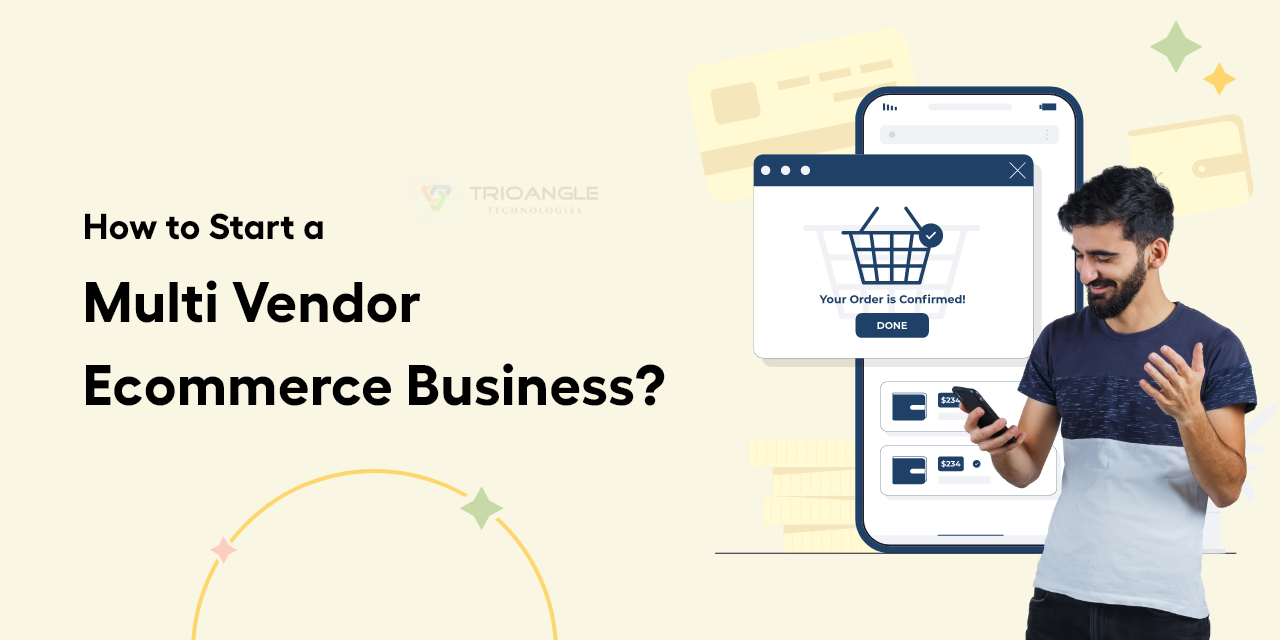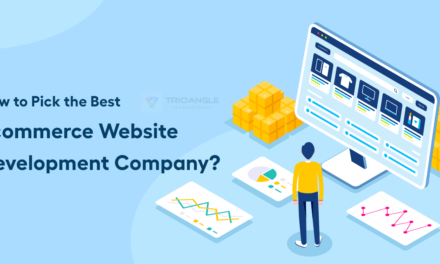Welcome to our blog post on how to create a multi vendor ecommerce business without code! 🙏
In today’s digital age, e-commerce has experienced a tremendous boom. The multi vendor ecommerce business have become a popular avenue for entrepreneurs and businesses to connect buyers and sellers in one platform.
The convenience and versatility offered by these marketplaces have changed how people buy and sell products and services online.
These multi vendor ecommerce business unlock new opportunities and redefine the online shopping experience.
What’s exciting is the chance to create such a dynamic marketplace without writing a single line of code. Interesting nah?
Here, we’ll delve into the captivating world of building a multi vendor ecommerce platform without code.
Are you ready to delve in? Great! Go ahead!!! 👍

Planning your multi vendor ecommerce business
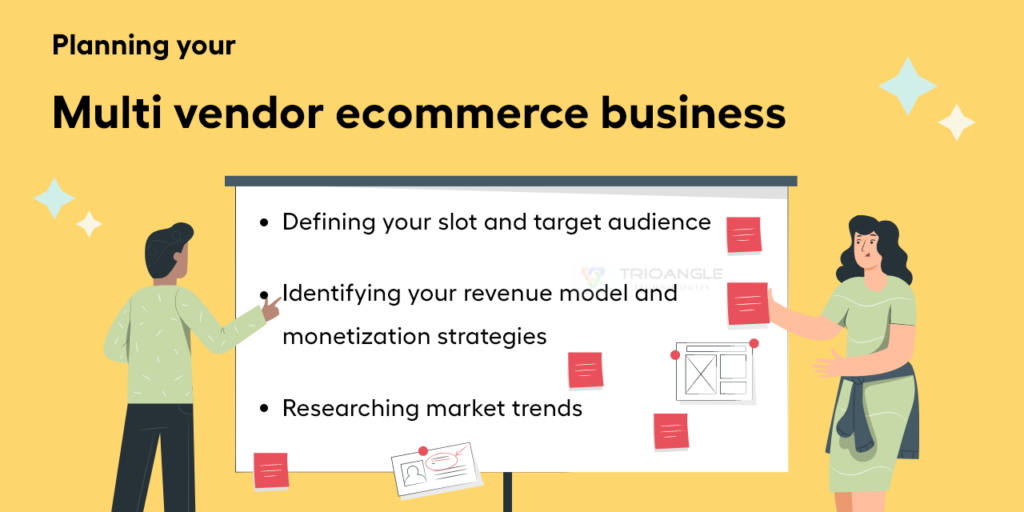
Defining your slot and target audience
Planning is essential to start a multi vendor ecommerce business. Right from choosing the business to its demand, you need to work out critically to ensure your chances of success.
Start with market research to identify which marketplace is thriving in your interest. Once you identified your marketplace, spot the potential gaps to differentiate yourself from the group.
There are plenty of multi vendor business types like e-commerce, food delivery, wholesale marketplaces, etc. These marketplace businesses are growing at the peak rate. You can select one or another that you think will thrive among the audience you target.
Identifying your revenue model and monetization strategies
The ultimate aim of knowing how to build a multi vendor ecommerce business is to yield handsome revenue, isn’t it? If you even start just for servicing, you need some revenue to make your business stand high in the crowd.
Any side you stand, you need good revenue to run your business without a flop.
For that, you need to analyze the revenue model that suits your business idea.
If you start an e-learning marketplace platform means you can go with listing fees, data monetization, and subscriptions.
Here you can’t generate revenue from commissions or advertising models as they’re fair for e-commerce and other services selling platforms.
That’s why processing the revenue model types and experimenting with them is right for a proper income. All revenue models will not work for all business models. Specific models can yield better outcomes for your startup.
Researching market trends
Keeping your business with market trends is crucial to keep it up in this competitive era. Making use of the market trends will help your marketplace business to be in the trend. You can set your business to travel in a futuristic way that appeals to the upcoming generation too.
By researching market trends, you’ll come across things that make the business flow truly smooth. You’ll get a better idea when you work with many trends. By the end, you find the trend that works for your end users.
You’ll eventually generate new ideas for your business to make it thrive. And that idea will become trendy using which other business will succeed like you. One day, you’ll be the showstopper in the multi vendor ecommerce business industry.
Though planning is less relevant to creating a multi vendor ecommerce application without code, it’s essential. Because, without a plan, you can’t imagine how to build a multi vendor ecommerce business platform. The framework is the beginning of every app development process. Without this, your idea of the app cannot evolve and takes time to get mature.
Choosing the suitable platform
Introduction to no-code platforms for multi vendor ecommerce business
No-code platforms are gaining popularity over traditional software development processes. It enables individuals to create and launch multi vendor platforms without any technical knowledge.
These no-code multi vendor platforms are pre-built software. Investors can pick components, templates, visual interfaces, and features that are ready to work. They just have to design, customize, and launch their multi vendor platform to kick-start their business. And this is how to create a multi vendor ecommerce business for startups.
Moreover, the software consists of:
- User-friendly interfaces
- Vendor management tools
- Products listings and searching
- Virtual payments
- User reviews
- Freedom for customization
Creating a multi vendor ecommerce software without code greatly simplifies the development processes. At the same, it has limitations in terms of its flexibility, scalability, and adaptability. Even so, it promises a great start for entrepreneurs and businesses to quickly launch their marketplace without hurdles.
Popular no-code platforms to create a multi vendor ecommerce app
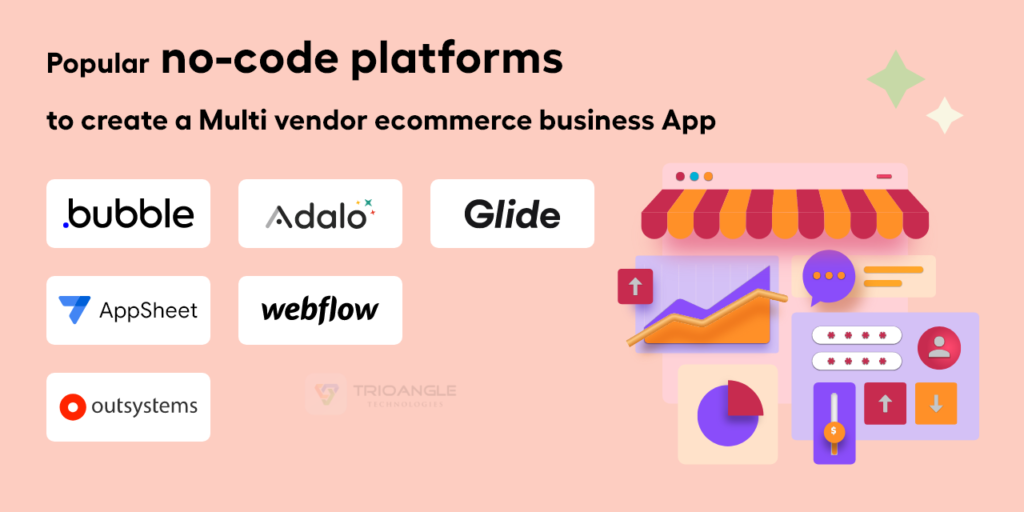
Bubble
The Bubble is a versatile platform that can handle the complexity of a multi vendor ecommerce business.
It offers robust backend abilities, letting you create user authentication systems, manage vendor accounts, handle product listings, and process transactions.
You can leverage Bubble’s database functionality to store and organize vendor, buyer, and product data. In addition, you can integrate it with payment gateways for protected transactions.
Adalo
Adalo is primarily focused on mobile app development. This platform can be advantageous if you want to create a mobile-centric multi vendor ecommerce business.
With Adalo, you can design vendor and product listings interfaces, create user authentication for vendors and buyers, and integrate payment gateways. Adalo also facilitates communication between users within the app.
You can use this platform if you focus more on mobile users and a user-centric approach. In those areas, Adalo provides its aid generously.
Glide
Glide is another suitable platform for creating a mobile-based multi vendor ecommerce business. You can leverage Glide’s data-driven spreadsheets to manage vendor and product data.
You can easily design app interfaces for vendors and buyers and innovative product listings.
Keep in mind that Glide’s functionality may need to be more flexible compared to other platforms. It’s a powerful and user-friendly no-code platform, but when it comes to devising complex marketplace requirements, it has considerable limitations.
Webflow
Webflow is an authentic no-code software-creating platform for website and web application development. This can be employed to develop a multi vendor ecommerce business platform.
You can design a visually appealing marketplace website. It appeals to web users and provides more detail compared to mobile applications. You can create product listing pages, and payment gateways, and incorporate user authentication features for your marketplace business’s website.
However, building an advanced marketplace functionality, such as inventory management, may require custom code or integrations.
OutSystems
OutSystems is an enterprise-grade no-code platform that offers extensive capabilities for building complex multi vendor ecommerce businesses.
Whether you lack knowledge in coding or have no time to code, with OutSystems, you can design and develop the necessary features for a multi vendor ecommerce business.
From product listings or viewing to transaction processing to users exiting the app, OutSystem has off-the-shelf attributes to help you integrate all the essential features of your business.
Its integration capabilities allow you to connect with various external systems and APIs required for marketplace operations.
AppSheet
AppSheet, with its focus on creating apps from spreadsheets, can be suitable for creating a simplified mobile-based multi vendor ecommerce business.
You can manage vendor, buyer, and product data in spreadsheets, and design apps in AppSheets by using data resources such as MS Excel, Google Sheets, etc. It’s like converting your spreadsheet data into a functional app that vendors and users use to buy and sell products.
Though you can create a standalone marketplace software with AppSheet, it has limitations when it comes to designing advanced marketplace platforms.
These are the solutions for how to create a multi vendor ecommerce business platform. Pick the best one for your marketplace app development project.
Factors to consider when choosing a platform
Convenience
Ensure the platform’s UI, visuals, features, and functionalities are easy to use. It streamlines your multi vendor ecommerce business app development process. It helps you especially if you have little or no coding experience.
Attributes
Attributes of the platforms should be assessed and compared with your marketplace’s specific requirements. If it lacks something that you need, you have to shift to another platform that fulfills your requirements.
Customization
Check the customization options the platform provides. Ensure the customizations are satisfying for your branding and design needs. Look if the layouts, styles, and designs are customizable. This is essential to create a unique marketplace experience.
Scalability
Scalability is crucial to handle increasing traffic, data volume, user base, and functionality. Find the platform that provides scalable infrastructure to support the future growth of your marketplace business.
Integrations
Platform integration ability is required for the smooth operation of marketplace business. Determine whether the platform is connectable with third-party services and APIs. if the platform doesn’t support payment gateways, shipping providers, or analytics tools integrations, then you should go with the platform that connects them.
Cost
You have to create a budget to measure which platform is your budget-friendly service provider. Evaluate the pricing structure of the no-coding platform. Compare it with your budget. Analyze the platform’s cost of hosting, transaction fees, or any additional charges for creating an application. Also, ensure whether the platform offers any free trial or something like that to explore its capabilities before committing your business to it.
Consider these factors and align them with your unique multi vendor ecommerce business needs. This is how to create multi vendor ecommerce business by choosing a suitable no-code platform that fits your ideas.
Designing and customizing your multi vendor ecommerce software
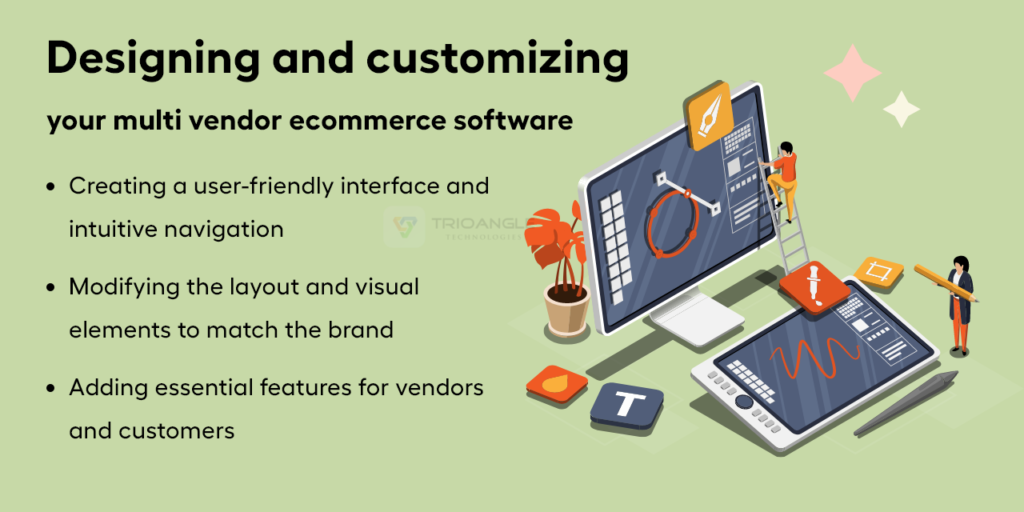
Creating a user-friendly interface and intuitive navigation
Know user personas
Knowing user personas will help to identify their pain points, preferences, and behaviors. Once you identify these aspects, you can tailor-cut the interfaces and navigation that suit their interests. And that’s what the multi vendor ecommerce software is.
Plan simple navigation
Create a step-by-step workflow to make the navigation conceivable and intuitive for users. When they think about the product, they should not worry about your app’s troubling navigation. Instead, the navigation should make their buy easier in the time they think about a purchase.
Utilize wireframing tools
Wireframing tools such as Figma, Sketch, and Balsamiq will help create visually appealing app layouts and screens. With wireframing tools, you can map out the placement of elements and interactions without coding knowledge.
Be consistent and no-frills
Keep your marketplace platform’s core functionality clean and consistent. Retain exact designs, graphic languages, colors, fonts, and icons throughout the app for better user recognition.
Prioritize quickness
Analyze the features that help users to immediately make purchases. Place those features easily findable on the dashboard page. Product search, add to cart, track order, and personalized product recommendations will help users to make instant purchases.
Mobile-first approach
Optimize your marketplace app to mobile screens since users are more likely to make purchases through smartphones. Ensure the app interface is responsive, viewable, and seamless for smaller screens.
Make navigation intuitive
Navigation is crucial to attract users. The navigation should be understandable, simple, and fast. These three things will make the user’s understanding better. They can make the next step within the app only if they comprehend the app’s subtle navigation.
Modifying the layout and visual elements to match the brand
Choose a suitable color scheme
Your multi vendor ecommerce business identity should be reflected in the color scheme you chose. If you choose fruits and vegies marketplace, go with red, green, and yellow colors. It’ll induce some fresh sensation in the minds of viewers.
Create a logo
Design a logo that is easy to grasp and represents your brand. Make it delicate and recognizable. Fix it into the app’s header to reinforce your brand into users.
Typography
Signature is for humans and typography is for businesses. Typography reflects your brand identity instantly. It should be easy to read, unlike signatures. Include a combination of fonts, colors, and styles to create a visual hierarchy.
Maintain consistency
Visual consistency is crucial to augment brand recognition. Maintain consistency from the beginning to the end of the marketplace app to create a unified and coherent brand experience.
Adding essential features for vendors and customers
For a multi vendor ecommerce app, some essential features are vital for vendors and consumers. Here are some of them:
Vendors features:
- Vendor registration
- Product listing
- Order management
- Inventory administration
- Communication channels
- Analytics and reports
- Payment integration
Customers features:
- Customer signup
- Product dashboard
- Search items
- Digital cart
- Ratings and reviews
- Digital pay
- Order tracking and history
Last notes
Today, starting a multi vendor ecommerce application is achievable without hardships. We have seen how it’s possible and how you can go with it to build a robust marketplace app. In this journey, you need to be very calculative in building apps.
No coding apps may sound great, but this way of approach has cons too. Ensure the cons are not a big deal for your business and make yourself ready to build a personalized app in the meantime.
Before that, immediately start building your marketplace platform without code. It’s the right time to enter the industry and attract audiences to your side. And no code app development is the only solution you have right now to produce and launch an innovative marketplace platform quickly! 💐

